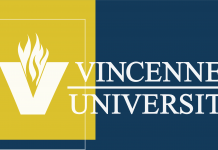FINAL REALIGNMENT PLANÂ
Evansville— 3/11/21 —The President of the University of Evansville (UE), Christopher M.Pietruszkiewicz, today unveiled his final realignment plan for the university. That plan explains how the university will restructure its academics, athletics, and administration. While the plan was revealed to faculty, staff, and most administrators today, the Executive Committee of the Board of Trustees approved the plan on Monday and it will go before the full Board sometime today.
Within the realignment plan, there are cuts to the administration. Twelve administrative positions in the Department of Academic Affairs, the Department of Fiscal Affairs and Administration, and the Department of Student Affairs will be eliminated, although the President did note that five of those positions are already vacant. The President also said that, while the university will retain its NCAA Division I status and all seventeen of its sports, there will be savings in the Athletics department. In explaining how this would work, the President did not directly state that there would be any dismissals within that department. Nonetheless, we send our condolences to all staff and administrators who have been or are scheduled to be eliminated. The UE AAUP recognizes and values the essential contribution made to the university by its staff and administrators.
The bulk of the savings within the President’s realignment plan will come from the faculty. While some of these savings will derive from phased retirements and “redesigned positions,†most are a product of the fact that, to quote today’s announcement, nineteen faculty members “elected to participate in the voluntary separation program.†The departing include a number of the most experienced, most distinguished members of the faculty. Their loss will significantly reduce the quality of teaching at the university, the research profile of the university, the range of courses offered by the university, and the university’s ability to recruit and retain students. To put it simply, the damage will be irreparable.
The primary reason that a large proportion of the faculty has chosen to leave the university is President Pietruszkiewicz’s realignment process. Following the initial announcement of this process last August, the faculty repeatedly tried to participate in it but were met with only empty promises of future involvement. It therefore came as a complete shock to the faculty when, on December 10th, the President put forward a draft academic realignment plan that called for the elimination of three departments, eighteen majors, and thirty-eight faculty members. Once the data that informed this plan was released to the faculty, it quickly became clear that the used data was subjective, incomplete, and simplistic. Nonetheless, provisional notices of dismissal were shortly thereafter sent out to the faculty members targeted for elimination.
The President, in his benevolence, allowed those faculty members to plead for their jobs by submitting “proposals†to the Provost. In those proposals, the threatened faculty members were supposed to argue for the necessity of retaining their positions and, in some cases, their programs and departments. Had the faculty as a whole been involved in the construction of the draft academic realignment plan, these proposals would not have been necessary. Had the Senior Administration acted with due diligence in assessing the university’s academics, most of the data contained within those proposals would already have been known to them. Yet, despite the farcical nature of the process, many faculty members understandably felt they had no choice but to submit such proposals to the Provost. The university publicly touted the meetings in which those proposals were offered as being “meaningful and productive,†but a survey of the faculty conducted by the Faculty Senate showed that seventy percent of the faculty members who attended such meetings did not see them that way.
What made the proposal process even more difficult for the faculty to accept is that it was the only means of participation in the construction of the final academic realignment plan that the Senior Administration offered. The university’s bylaws make it abundantly clear that the faculty has primary responsibility over educational policy and so educational changes such as program deletions must go through the Faculty Senate. The President, however, ignored this and, on rolling out his plan, accorded the faculty no decision-making role. When the issue of the faculty’s relationship to educational policy was raised by a Senate resolution, the President responded that his plan was “not an educational policy decision, but an administrative decision†and so did not need be approved by the faculty. It was only after considerable internal and external pushback to this pronouncement that the President reversed his position on this subject and, in a January 27th e-mail to the faculty, pledged to submit any program deletions to the Senate’s Curriculum Committee. However, the President seems to have forgotten this message because, in today’s announcement, he spoke of the deletion of three majors (Art History, Philosophy, Religion). Even though those program deletions have not been reviewed by any faculty body, the Board of Trustees will vote on them tomorrow. The UE AAUP pledges to investigate this matter further.
By early 2021, the consequences of the President’s draft academic realignment plan were starting to become clear. Faculty were protesting. Alumni were angry. Current students were frightened.
Prospective students were deterred. Community members were outraged. Amidst all this, the burden of trying to quell concerns fell on already overworked staff and administrators rather than the leadership team that started the whole fiasco. Eventually, the President realized that the university could not function properly in such a state of discord and so, in early February, he walked back his decision to entirely eliminate the Music department. It would be allowed to remain, albeit with fewer full-time faculty members.
The other departments impacted by the President’s draft academic realignment plan learned of their fates today. As has so often been the case during the realignment process, it was the Senior Administration’s decisions regarding the department of Electrical Engineering and Computer Science (EECS) that most fully showcased the ineptitude of the President and his team:
Computer Engineering, Electrical Engineering, and Software Engineering will pause in admissions of new freshman for one year as potential options for redesigning these majors are evaluated.
The hiring of qualified visiting professors will ensure all current students in these programs will be able to continue their studies through graduation without any anticipated changes to our ABET accreditation status during this time.
Aside from the fact that UE doesn’t have a Software Engineering program, what is most noticeable about this passage is that fact that the offered solutions entirely fail to solve the myriad problems created by the announcement of the elimination of the EECS department. Several of that department’s students have already left and more are planning to transfer. Enrollment for the fall is abysmal. Pausing admissions is merely an attempt to hide the damage the President has done to recruitment efforts for next year. Furthermore, in delaying a final decision on the future of the EECS department, the President is hampering the department’s efforts to retain its students.
In light of everything that has happened this academic year, it is entirely understandable that many faculty members have chosen to leave the university. Indeed, over the three years that Christopher M. Pietruszkiewicz has been the president of the University of Evansville, over fifty faculty members have voluntarily or involuntarily departed. This represents approximately a third of the full-time faculty.
During the same period, the university has witnessed a precipitous decline in enrollment as prospective students begin to question the quality and value of a degree from the University of Evansville. As long as Christopher M. Pietruszkiewicz remains the president of the University of Evansville, there is likely to be a continuous stream of voluntary and involuntary departures. It is hard to envisage a scenario in which the realignment’s damage to enrollment and retention does not quickly result in another round of academic cuts. For the university to survive, it must end its ongoing cycle in which faculty reductions lead to enrollment reductions which in turn lead to faculty reductions. The necessary first step in ending this cycle is for the university to acquire a leadership team that not only understands UE’s educational mission but also values those who carry out that mission. Until that happens, the bleeding can only get worse.
Sincerely,
Daniel Byrne, Secretary-Treasurer UE AAUP,
FOOTNOTE:  To learn more:  • Visit our website at saveue.com • Follow us on Facebook at Save UE. Follow us on Twitter at @Save_UE • Follow us on Instagram at save.ue.  E-mail us at ueaaup@gmail.com





UE Athletic should be D3. Time to get back to the mindset that the ultimate goal is a college education. UE, much as it pains me to say it, has NO business in D1 sports anymore. The NCAA landscape has drastically changed and will continue.
Comments are closed.